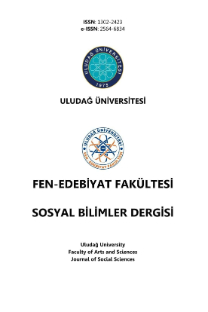''HIBE'' as an industrument of transgeneration commodity transfer in the Ottoman society
Osmanlı çalışmalarında kuşaklararası sermaye transferi olarak hibe bugüne kadar ayrı bir çalışma konusu olmamıştır. Makalenin amacı konuyu bir araştırma problemi olarak ortaya koymaktır. Kaynak olarak Bursa, Kayseri, Kastamonu ve Mardin gibi farklı şehirlerin rastgele seçilen mahkeme kayıtlarından yararlanılmıştır. Konunun daha geniş olarak araştırılması, pek çok başka başlıkla beraber henüz neredeyse hiç bir fikrimiz olmayan yaş grupları meselesini de anlamaya katkı sağlayacaktır.
‘Donation as a means for intergenerational capital transfer’ has not become a separate research subject in the Ottoman studies so far today. The aim of the present article is to put forward the subject as a research problem. Data were collected from randomly selected court records of such cities as Bursa, Kayseri, Kastamonu and Mardin. More comprehensive study of the present research subject will also contribute to our understanding of the matter of age groups about which we almost have no idea in addition to many other titles.
___
- Akyılmaz, Gül (2005), “Osmanlı Hukukunda Köleliğin Sona Ermesi İle İlgili Düzenlemeler ve Tanzimat Fermanı’nın İlanından Sonra Kölelik Müessesesi”, Gazi Üniversitesi Hukuk Fakültesi Dergisi, 9, (1-2), 209-235.
- Aykan, Hakan-Wolf, Douglas, A. (2000), “Traditionality, Modernity, and Household Composition: Parent-Child Coresidence in Contemporary Turkey”, Research on Aging, 22, (4), 395-421.
- Bursa Şer’iye Sicili, B 179/ 395 (H.1175-1176, M.1761-1762).
- Bursa Şer’iye Sicili, B 226/454 (H.1199-1200, M. 1784-1785).
- Bursa Şer’iye Sicili, B 90/295 (H.1081-1082, M.1670-1671).
- Diefendorf, Barbara B. (1982), “Widowhood and Remarriage in Sixteenth- Century Paris”, Journal of Family History, 7 (4), 379-395.
- Ergene, Boğaç-Berker, Ali (2009), “Inheritance and Intergenerational Wealth Transmission in Eighteenth-Century Ottoman Kastamonu: an Empirical Investigation”, Journal of Family History, 34, (1), 25-47.
- Esen, Hüseyin (2005), “İslam Hukukunda Ölümün Mâlî Hak ve Borçlara Etkisi”, Cumhuriyet Üniversitesi İlahiyat Fakültesi Dergisi, 9, 55-86.
- Faroqhi, Suraiya (1976), “The Tekke of Haci Bektas: Social Position and Economic Activities”, International Journal of Middle East Studies, 7, (2),183-208.
- Gerber, Haim (1989), “Anthropology and Family History: the Ottoman and Turkish Families”, Journal of Family History, 14, (4), 409-421.
- Ginio, Eyal (2006), “The Shaping of a Sacred Space: The Tekke of Zuhuri Seyh Ahmet Efendi in Eighteenth-century Salonica”, The Medieval History Journal, 9, (2), 271-296.
- Glass, Jennifer and et al. (1986), “Attitude Similarity in Three-generation Families: Socialization, Status, Inheritance, or Reciprocal Influence?”, American Sociological Review, 51, (5), 685-698.
- Güngör, Ekrem (2006), 1 Numaralı Kütahya Şer’iyye Sicili (II.Bölüm) Transkripsiyonu ve Kritiği, Yayınlanmamış Yüksek Lisans Tezi, (Dumlupınar Üniversitesi Sosyal Bilimler Enstitüsü), Kütahya, 2006.
- Hiroyuki, Yanagihashi (1998), “The Doctrinal Development of "Maraḍ al- Mawt" in the Formative Period of Islamic Law”, Islamic Law and Society, 5, (3), The Islamic Inheritance, 326- 358.
- Inalcik Halil (1969), “Capital Formation in the Ottoman Empire”, Journal of Economic History, 29, (1), 97-140.
- Kankal, Ahmet and Kenan Z. Taş (eds.), 252 Nolu Mardin Şeriye Sicili Belge Özetleri ve Mardin (2006), Mardin Tarihi İhtisas Kütüphanesi Yay. No:5, Mardin Şer’iye Sicilleri Serisi:3, İstanbul.
- Kreiser, Klaus (2002), “Women in the Ottoman World: a Bibliographical Essay”, Islam & Christian-Muslim Relations, 13, (2), 197-206.
- Kurumlar, Zaliha, Ay (2006), 69/1 Numaralı Kastamonu Şer’iyye Sicili (H. 1210- 1211 / M. 1795-1796) Transkripsiyon ve Değerlendirme, Yayınlanmamış Yüksek Lisans Tezi, (Erciyes Üniversitesi Sosyal Bilimler Enstitüsü), Kayseri.
- Laurence, J. Kotlikoff-Lawrence Summers, “The Role of Intergenerational Transfers in Aggregate Capital Accumulation”, NBER Working Paper, February, 1980.
- Layish, Aharon (1990), “The Druze Testamentary waqf”, Studia Islamica, 127-154.
- Layish. Aharon (1997), “The Family Waqf and the Sharī Law of Succession in Modern Times” Islamic Law and Society, 4, (3), 352-388.
- Maydaer, Saadet (2006), “Osmanlı Klâsik Döneminde Kadınların Servet Edinme Yolları (Bursa Örneği)”, Uludağ Üniversitesi İlahiyat Fakültesi Dergisi, 15, (2).
- Maydaer, Saadet (2007), “Klâsik Dönem Osmanlı Toplumunda Boşanma (Bursa Şer’iyye Sicillerine Göre)”, Uludağ Üniversitesi İlahiyat Fakültesi Dergisi, 16, (1), s.299-320.
- McGranahan, Leslie Moscow (2000), “Charity and the Bequest Motive: Evidence from Seventeenth-Century Wills”, Journal of Political Economy, 108, (6), 1270-1291.
- Perozek,Maria G. (1998), “Reexamination of the Strategic Bequest Motive”, The Journal of Political Economy, 106, (2), 423-445.
- Pierce, Leslie, (2005), Ahlak Oyunları 1540-1541 Osmanlı’da Ayntab Mahkemesi ve Toplumsal Cinsiyet, Çev. Ülkün Tansel, Tarih Vakfı Yurt Yay., İstabul.
- Powers, David S. (1990), “The Islamic Inheritance System: A Socio- Historical Approach,” In Islamic Family Law, ed. Chibli Mallat and Jane Conners London: Graham & Trotmann, 11-29.
- Powers, David S. (1998), “The Art of the Judicial Opinion: On Tawlij In Fifteenth-century Tunis”, Islamic Law and Society, 5, (3), 359-381.
- Remle, Robert Korey (2008), Kinship Status And Life Course Transitions As Determinants Of Financial Assistance To Adult Children, (ph.D. Thesis),Duke University.
- Rozen, Minna (1996), “The Life Cycle and the Significance of Old Age During the Ottoman Period”, In Daniel Capri Jubilee Volume, edited by D. Porat, and Minna Rozen, Tel-Aviv University, Hayim Rosenberg School of Jewish Studies, 109-175.
- Udovitch, Abraham (1970), “Theory and Practice of Islamic Law: Some Evidence from the Geniza”, Studia Islamica, 32, 289-303.
- ISSN: 1302-2423
- Yayın Aralığı: Yılda 2 Sayı
- Başlangıç: 1999
- Yayıncı: Bursa Uludağ Üniversitesi
Sayıdaki Diğer Makaleler
Lover and the world Sultan ( Muhibbi )
Bursa Ulucamii'nin geçirdiği Tamirler
Atatürk dönemi Bursa'sında tıp çalışmaları-1
Klasik Türk şiirinde Derviş tipi
The ideal Turkish youth and teacher in Mehmet Akif Ersoy's poems
The ideal Turkish youth and teacher in Mehmet Akif Ersoy's poems
+/A- Ekinin Kırım Tatar Türkçesindeki kullanılışı üzerine
Bandırmalızade Haşim Baba divanı'nda tasavvufi unsurlar
Bandırmalızade Haşim Baba divanı'nda tasavvufi unsurlar
